Financial and Management Accounting Analysis Report - University
VerifiedAdded on 2023/06/04
|8
|2232
|398
Report
AI Summary
This report provides a comprehensive analysis of financial and management accounting principles. It begins with the calculation of gross and net profit, including the computation of relevant ratios to assess the profitability of a business. The report then identifies the reasons for declining profits, such as excess inventory, delayed payments from debtors, and inefficient rent expenses. Strategies to improve the financial position are proposed, including better debt collection control, updated marketing techniques, and offering discounts. Furthermore, the report delves into break-even analysis, outlining the advantages and disadvantages of activity-based costing. Finally, it examines variance analysis, identifying significant variances in direct power costs, indirect administration costs, and premises costs, along with their potential causes. The report concludes with strategies to correct these variances, such as implementing zero-based budgeting, and discusses its advantages and disadvantages. References to relevant academic sources are provided throughout the report.
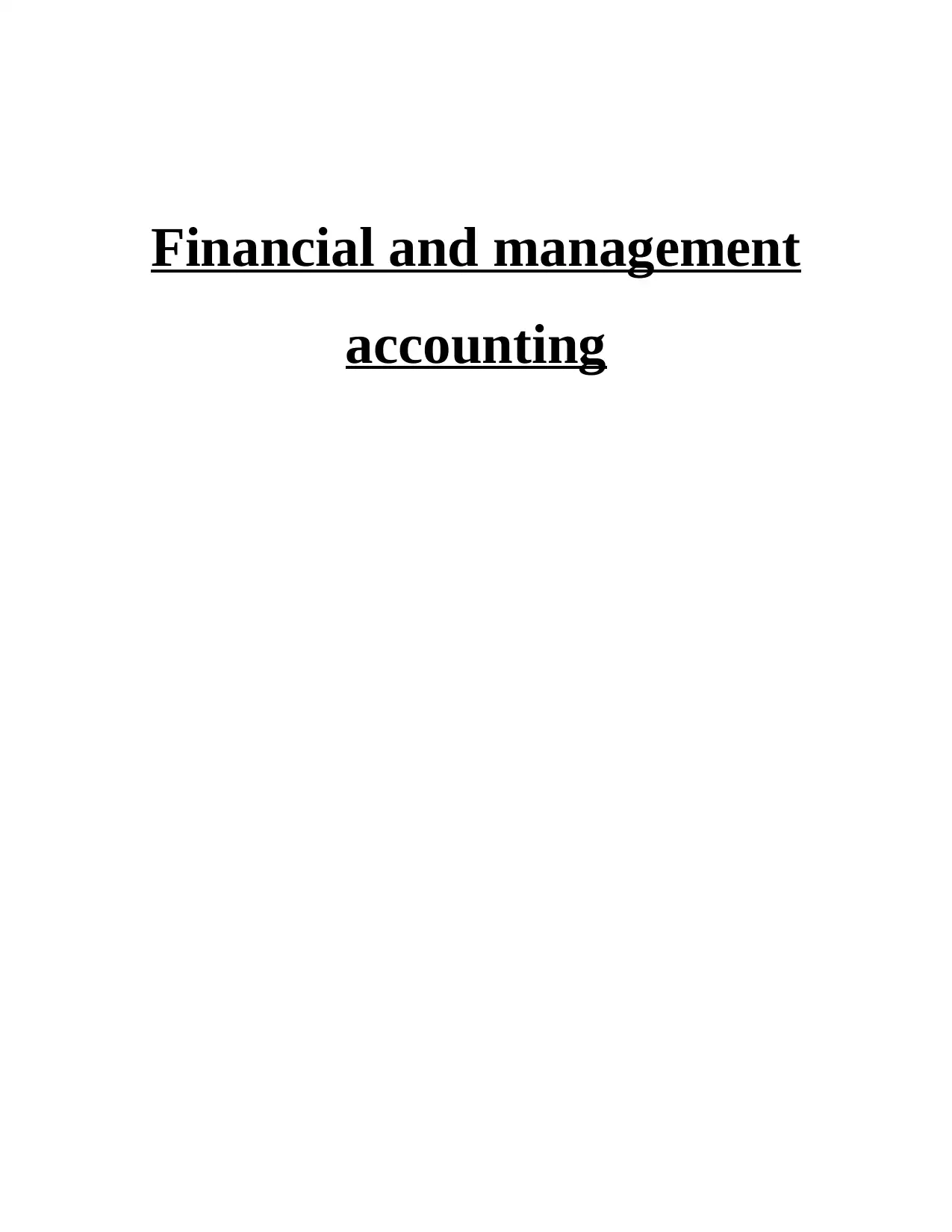
Financial and management
accounting
accounting
Paraphrase This Document
Need a fresh take? Get an instant paraphrase of this document with our AI Paraphraser
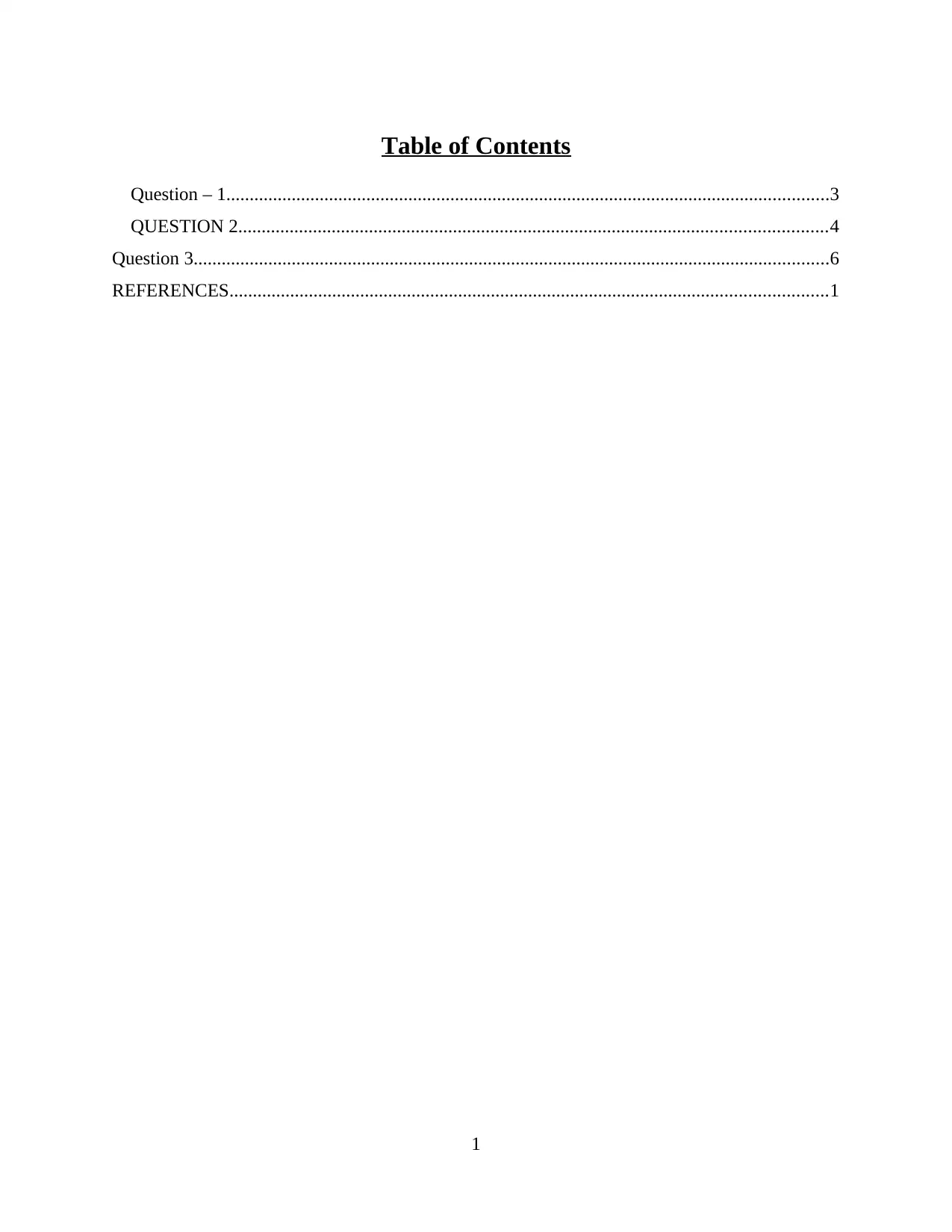
Table of Contents
Question – 1.................................................................................................................................3
QUESTION 2..............................................................................................................................4
Question 3........................................................................................................................................6
REFERENCES................................................................................................................................1
1
Question – 1.................................................................................................................................3
QUESTION 2..............................................................................................................................4
Question 3........................................................................................................................................6
REFERENCES................................................................................................................................1
1
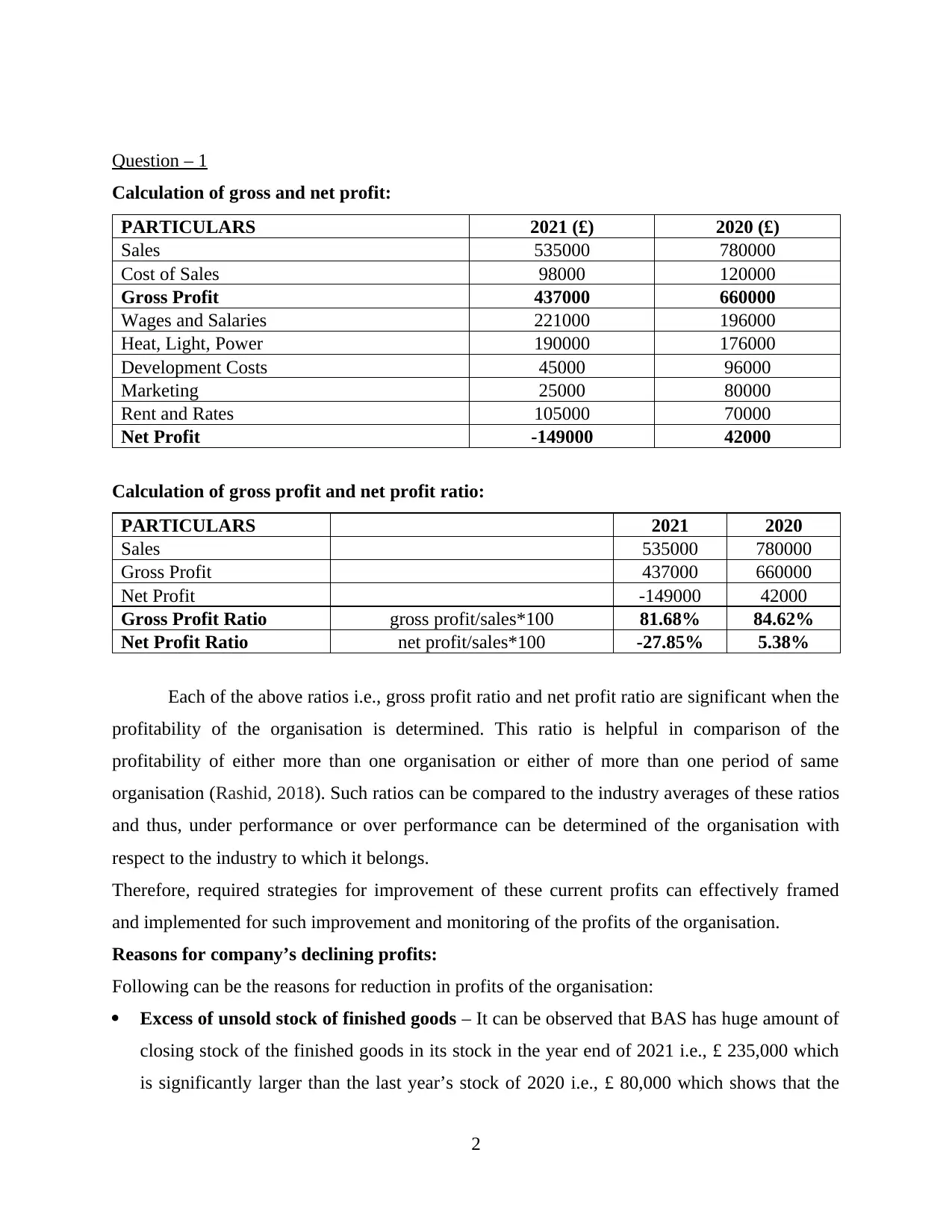
Question – 1
Calculation of gross and net profit:
PARTICULARS 2021 (£) 2020 (£)
Sales 535000 780000
Cost of Sales 98000 120000
Gross Profit 437000 660000
Wages and Salaries 221000 196000
Heat, Light, Power 190000 176000
Development Costs 45000 96000
Marketing 25000 80000
Rent and Rates 105000 70000
Net Profit -149000 42000
Calculation of gross profit and net profit ratio:
PARTICULARS 2021 2020
Sales 535000 780000
Gross Profit 437000 660000
Net Profit -149000 42000
Gross Profit Ratio gross profit/sales*100 81.68% 84.62%
Net Profit Ratio net profit/sales*100 -27.85% 5.38%
Each of the above ratios i.e., gross profit ratio and net profit ratio are significant when the
profitability of the organisation is determined. This ratio is helpful in comparison of the
profitability of either more than one organisation or either of more than one period of same
organisation (Rashid, 2018). Such ratios can be compared to the industry averages of these ratios
and thus, under performance or over performance can be determined of the organisation with
respect to the industry to which it belongs.
Therefore, required strategies for improvement of these current profits can effectively framed
and implemented for such improvement and monitoring of the profits of the organisation.
Reasons for company’s declining profits:
Following can be the reasons for reduction in profits of the organisation:
Excess of unsold stock of finished goods – It can be observed that BAS has huge amount of
closing stock of the finished goods in its stock in the year end of 2021 i.e., £ 235,000 which
is significantly larger than the last year’s stock of 2020 i.e., £ 80,000 which shows that the
2
Calculation of gross and net profit:
PARTICULARS 2021 (£) 2020 (£)
Sales 535000 780000
Cost of Sales 98000 120000
Gross Profit 437000 660000
Wages and Salaries 221000 196000
Heat, Light, Power 190000 176000
Development Costs 45000 96000
Marketing 25000 80000
Rent and Rates 105000 70000
Net Profit -149000 42000
Calculation of gross profit and net profit ratio:
PARTICULARS 2021 2020
Sales 535000 780000
Gross Profit 437000 660000
Net Profit -149000 42000
Gross Profit Ratio gross profit/sales*100 81.68% 84.62%
Net Profit Ratio net profit/sales*100 -27.85% 5.38%
Each of the above ratios i.e., gross profit ratio and net profit ratio are significant when the
profitability of the organisation is determined. This ratio is helpful in comparison of the
profitability of either more than one organisation or either of more than one period of same
organisation (Rashid, 2018). Such ratios can be compared to the industry averages of these ratios
and thus, under performance or over performance can be determined of the organisation with
respect to the industry to which it belongs.
Therefore, required strategies for improvement of these current profits can effectively framed
and implemented for such improvement and monitoring of the profits of the organisation.
Reasons for company’s declining profits:
Following can be the reasons for reduction in profits of the organisation:
Excess of unsold stock of finished goods – It can be observed that BAS has huge amount of
closing stock of the finished goods in its stock in the year end of 2021 i.e., £ 235,000 which
is significantly larger than the last year’s stock of 2020 i.e., £ 80,000 which shows that the
2
⊘ This is a preview!⊘
Do you want full access?
Subscribe today to unlock all pages.

Trusted by 1+ million students worldwide
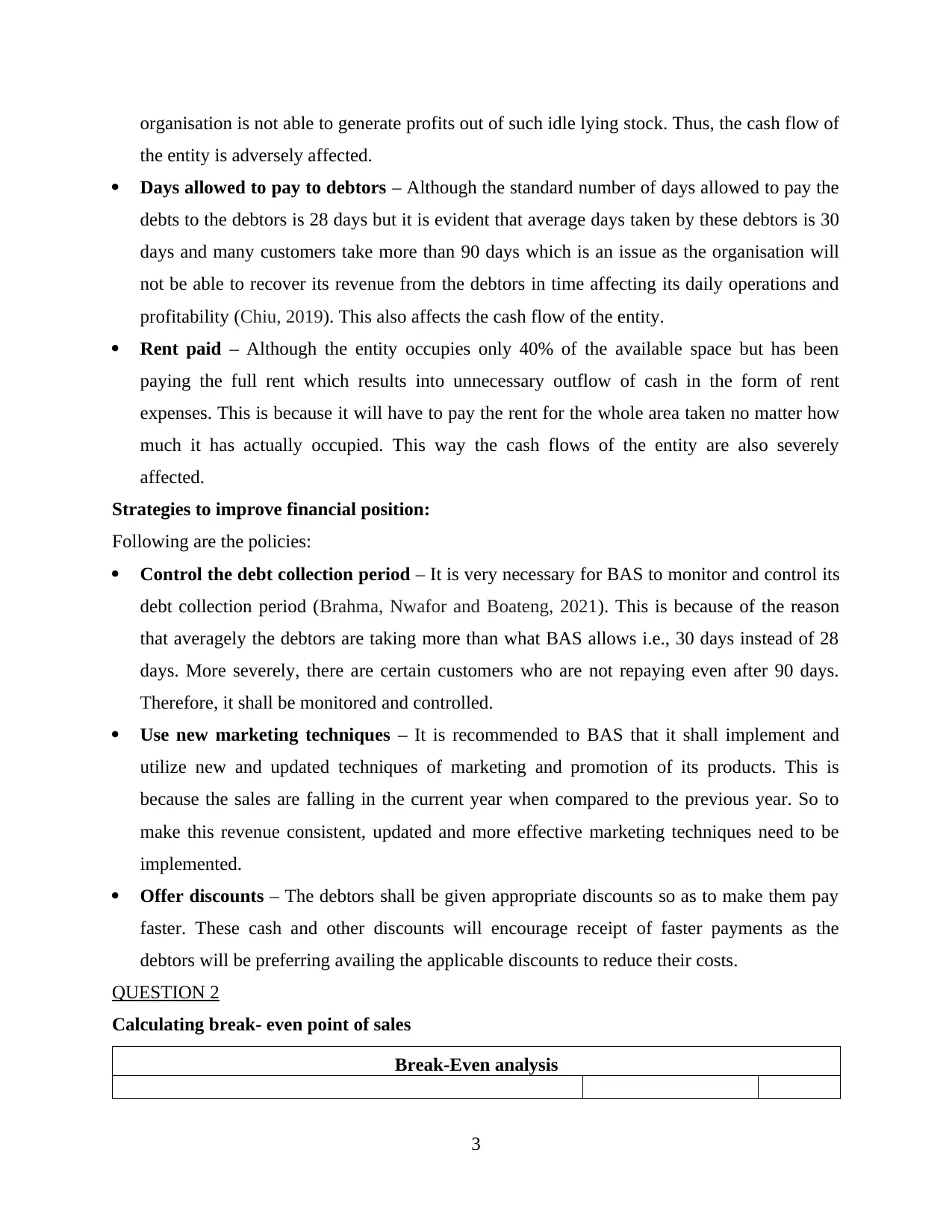
organisation is not able to generate profits out of such idle lying stock. Thus, the cash flow of
the entity is adversely affected.
Days allowed to pay to debtors – Although the standard number of days allowed to pay the
debts to the debtors is 28 days but it is evident that average days taken by these debtors is 30
days and many customers take more than 90 days which is an issue as the organisation will
not be able to recover its revenue from the debtors in time affecting its daily operations and
profitability (Chiu, 2019). This also affects the cash flow of the entity.
Rent paid – Although the entity occupies only 40% of the available space but has been
paying the full rent which results into unnecessary outflow of cash in the form of rent
expenses. This is because it will have to pay the rent for the whole area taken no matter how
much it has actually occupied. This way the cash flows of the entity are also severely
affected.
Strategies to improve financial position:
Following are the policies:
Control the debt collection period – It is very necessary for BAS to monitor and control its
debt collection period (Brahma, Nwafor and Boateng, 2021). This is because of the reason
that averagely the debtors are taking more than what BAS allows i.e., 30 days instead of 28
days. More severely, there are certain customers who are not repaying even after 90 days.
Therefore, it shall be monitored and controlled.
Use new marketing techniques – It is recommended to BAS that it shall implement and
utilize new and updated techniques of marketing and promotion of its products. This is
because the sales are falling in the current year when compared to the previous year. So to
make this revenue consistent, updated and more effective marketing techniques need to be
implemented.
Offer discounts – The debtors shall be given appropriate discounts so as to make them pay
faster. These cash and other discounts will encourage receipt of faster payments as the
debtors will be preferring availing the applicable discounts to reduce their costs.
QUESTION 2
Calculating break- even point of sales
Break-Even analysis
3
the entity is adversely affected.
Days allowed to pay to debtors – Although the standard number of days allowed to pay the
debts to the debtors is 28 days but it is evident that average days taken by these debtors is 30
days and many customers take more than 90 days which is an issue as the organisation will
not be able to recover its revenue from the debtors in time affecting its daily operations and
profitability (Chiu, 2019). This also affects the cash flow of the entity.
Rent paid – Although the entity occupies only 40% of the available space but has been
paying the full rent which results into unnecessary outflow of cash in the form of rent
expenses. This is because it will have to pay the rent for the whole area taken no matter how
much it has actually occupied. This way the cash flows of the entity are also severely
affected.
Strategies to improve financial position:
Following are the policies:
Control the debt collection period – It is very necessary for BAS to monitor and control its
debt collection period (Brahma, Nwafor and Boateng, 2021). This is because of the reason
that averagely the debtors are taking more than what BAS allows i.e., 30 days instead of 28
days. More severely, there are certain customers who are not repaying even after 90 days.
Therefore, it shall be monitored and controlled.
Use new marketing techniques – It is recommended to BAS that it shall implement and
utilize new and updated techniques of marketing and promotion of its products. This is
because the sales are falling in the current year when compared to the previous year. So to
make this revenue consistent, updated and more effective marketing techniques need to be
implemented.
Offer discounts – The debtors shall be given appropriate discounts so as to make them pay
faster. These cash and other discounts will encourage receipt of faster payments as the
debtors will be preferring availing the applicable discounts to reduce their costs.
QUESTION 2
Calculating break- even point of sales
Break-Even analysis
3
Paraphrase This Document
Need a fresh take? Get an instant paraphrase of this document with our AI Paraphraser
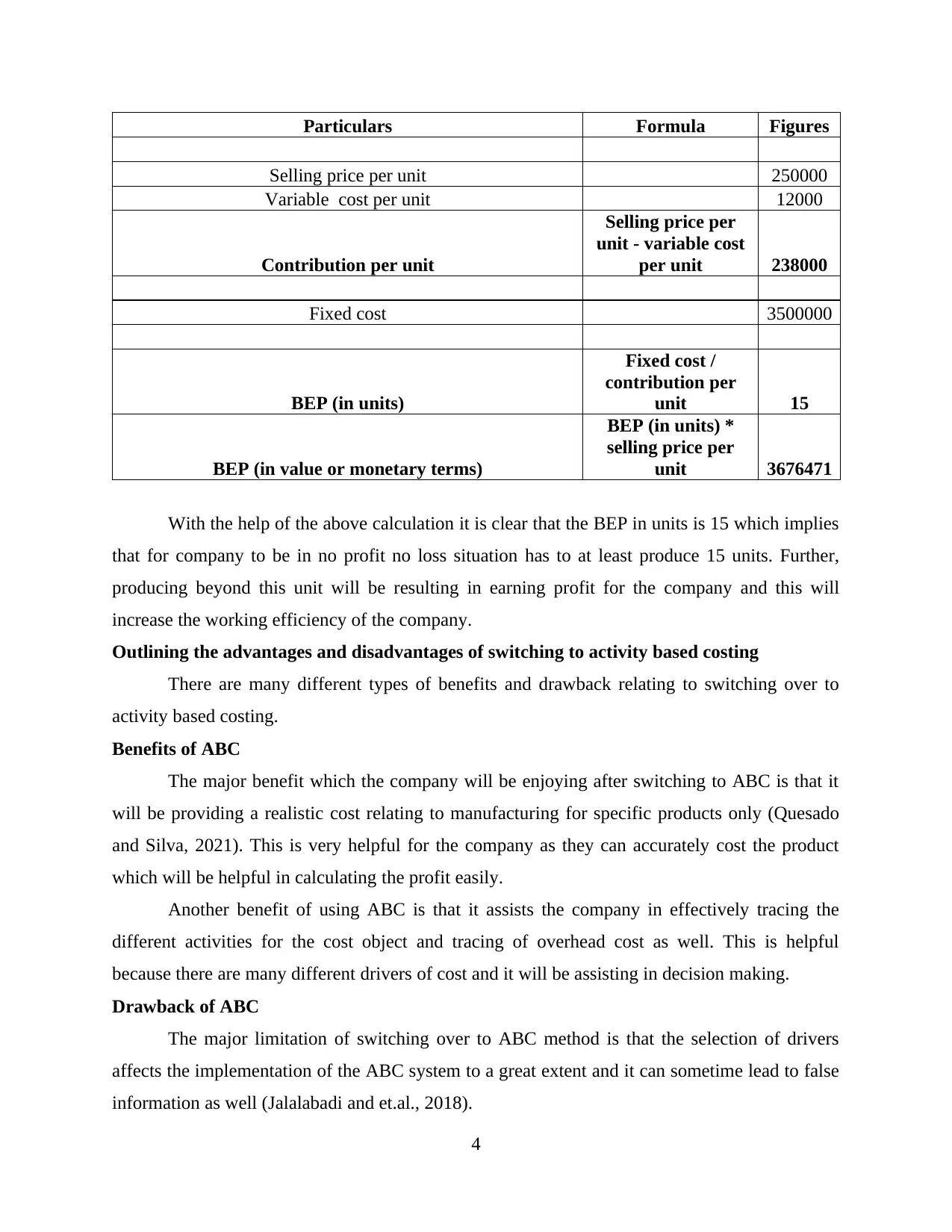
Particulars Formula Figures
Selling price per unit 250000
Variable cost per unit 12000
Contribution per unit
Selling price per
unit - variable cost
per unit 238000
Fixed cost 3500000
BEP (in units)
Fixed cost /
contribution per
unit 15
BEP (in value or monetary terms)
BEP (in units) *
selling price per
unit 3676471
With the help of the above calculation it is clear that the BEP in units is 15 which implies
that for company to be in no profit no loss situation has to at least produce 15 units. Further,
producing beyond this unit will be resulting in earning profit for the company and this will
increase the working efficiency of the company.
Outlining the advantages and disadvantages of switching to activity based costing
There are many different types of benefits and drawback relating to switching over to
activity based costing.
Benefits of ABC
The major benefit which the company will be enjoying after switching to ABC is that it
will be providing a realistic cost relating to manufacturing for specific products only (Quesado
and Silva, 2021). This is very helpful for the company as they can accurately cost the product
which will be helpful in calculating the profit easily.
Another benefit of using ABC is that it assists the company in effectively tracing the
different activities for the cost object and tracing of overhead cost as well. This is helpful
because there are many different drivers of cost and it will be assisting in decision making.
Drawback of ABC
The major limitation of switching over to ABC method is that the selection of drivers
affects the implementation of the ABC system to a great extent and it can sometime lead to false
information as well (Jalalabadi and et.al., 2018).
4
Selling price per unit 250000
Variable cost per unit 12000
Contribution per unit
Selling price per
unit - variable cost
per unit 238000
Fixed cost 3500000
BEP (in units)
Fixed cost /
contribution per
unit 15
BEP (in value or monetary terms)
BEP (in units) *
selling price per
unit 3676471
With the help of the above calculation it is clear that the BEP in units is 15 which implies
that for company to be in no profit no loss situation has to at least produce 15 units. Further,
producing beyond this unit will be resulting in earning profit for the company and this will
increase the working efficiency of the company.
Outlining the advantages and disadvantages of switching to activity based costing
There are many different types of benefits and drawback relating to switching over to
activity based costing.
Benefits of ABC
The major benefit which the company will be enjoying after switching to ABC is that it
will be providing a realistic cost relating to manufacturing for specific products only (Quesado
and Silva, 2021). This is very helpful for the company as they can accurately cost the product
which will be helpful in calculating the profit easily.
Another benefit of using ABC is that it assists the company in effectively tracing the
different activities for the cost object and tracing of overhead cost as well. This is helpful
because there are many different drivers of cost and it will be assisting in decision making.
Drawback of ABC
The major limitation of switching over to ABC method is that the selection of drivers
affects the implementation of the ABC system to a great extent and it can sometime lead to false
information as well (Jalalabadi and et.al., 2018).
4
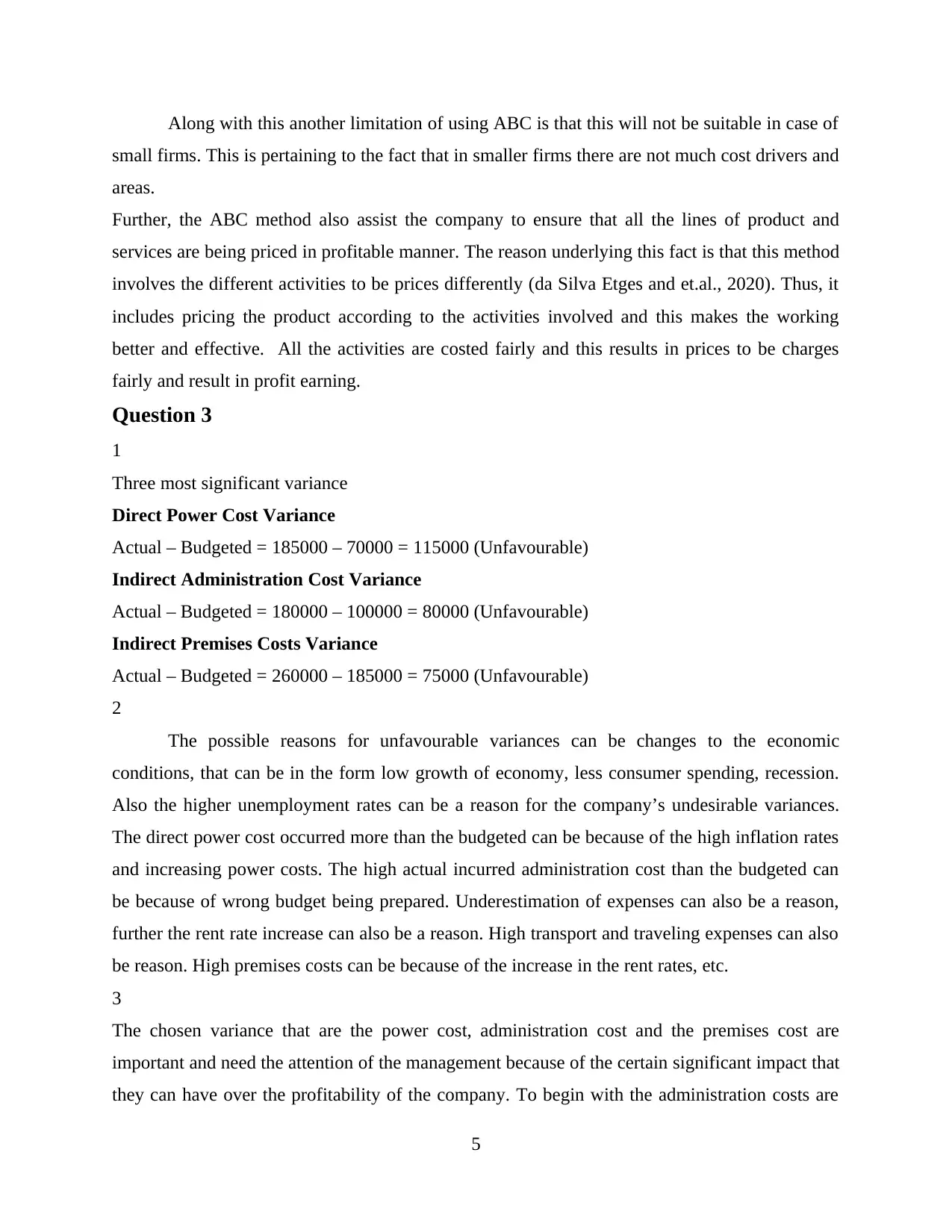
Along with this another limitation of using ABC is that this will not be suitable in case of
small firms. This is pertaining to the fact that in smaller firms there are not much cost drivers and
areas.
Further, the ABC method also assist the company to ensure that all the lines of product and
services are being priced in profitable manner. The reason underlying this fact is that this method
involves the different activities to be prices differently (da Silva Etges and et.al., 2020). Thus, it
includes pricing the product according to the activities involved and this makes the working
better and effective. All the activities are costed fairly and this results in prices to be charges
fairly and result in profit earning.
Question 3
1
Three most significant variance
Direct Power Cost Variance
Actual – Budgeted = 185000 – 70000 = 115000 (Unfavourable)
Indirect Administration Cost Variance
Actual – Budgeted = 180000 – 100000 = 80000 (Unfavourable)
Indirect Premises Costs Variance
Actual – Budgeted = 260000 – 185000 = 75000 (Unfavourable)
2
The possible reasons for unfavourable variances can be changes to the economic
conditions, that can be in the form low growth of economy, less consumer spending, recession.
Also the higher unemployment rates can be a reason for the company’s undesirable variances.
The direct power cost occurred more than the budgeted can be because of the high inflation rates
and increasing power costs. The high actual incurred administration cost than the budgeted can
be because of wrong budget being prepared. Underestimation of expenses can also be a reason,
further the rent rate increase can also be a reason. High transport and traveling expenses can also
be reason. High premises costs can be because of the increase in the rent rates, etc.
3
The chosen variance that are the power cost, administration cost and the premises cost are
important and need the attention of the management because of the certain significant impact that
they can have over the profitability of the company. To begin with the administration costs are
5
small firms. This is pertaining to the fact that in smaller firms there are not much cost drivers and
areas.
Further, the ABC method also assist the company to ensure that all the lines of product and
services are being priced in profitable manner. The reason underlying this fact is that this method
involves the different activities to be prices differently (da Silva Etges and et.al., 2020). Thus, it
includes pricing the product according to the activities involved and this makes the working
better and effective. All the activities are costed fairly and this results in prices to be charges
fairly and result in profit earning.
Question 3
1
Three most significant variance
Direct Power Cost Variance
Actual – Budgeted = 185000 – 70000 = 115000 (Unfavourable)
Indirect Administration Cost Variance
Actual – Budgeted = 180000 – 100000 = 80000 (Unfavourable)
Indirect Premises Costs Variance
Actual – Budgeted = 260000 – 185000 = 75000 (Unfavourable)
2
The possible reasons for unfavourable variances can be changes to the economic
conditions, that can be in the form low growth of economy, less consumer spending, recession.
Also the higher unemployment rates can be a reason for the company’s undesirable variances.
The direct power cost occurred more than the budgeted can be because of the high inflation rates
and increasing power costs. The high actual incurred administration cost than the budgeted can
be because of wrong budget being prepared. Underestimation of expenses can also be a reason,
further the rent rate increase can also be a reason. High transport and traveling expenses can also
be reason. High premises costs can be because of the increase in the rent rates, etc.
3
The chosen variance that are the power cost, administration cost and the premises cost are
important and need the attention of the management because of the certain significant impact that
they can have over the profitability of the company. To begin with the administration costs are
5
⊘ This is a preview!⊘
Do you want full access?
Subscribe today to unlock all pages.

Trusted by 1+ million students worldwide
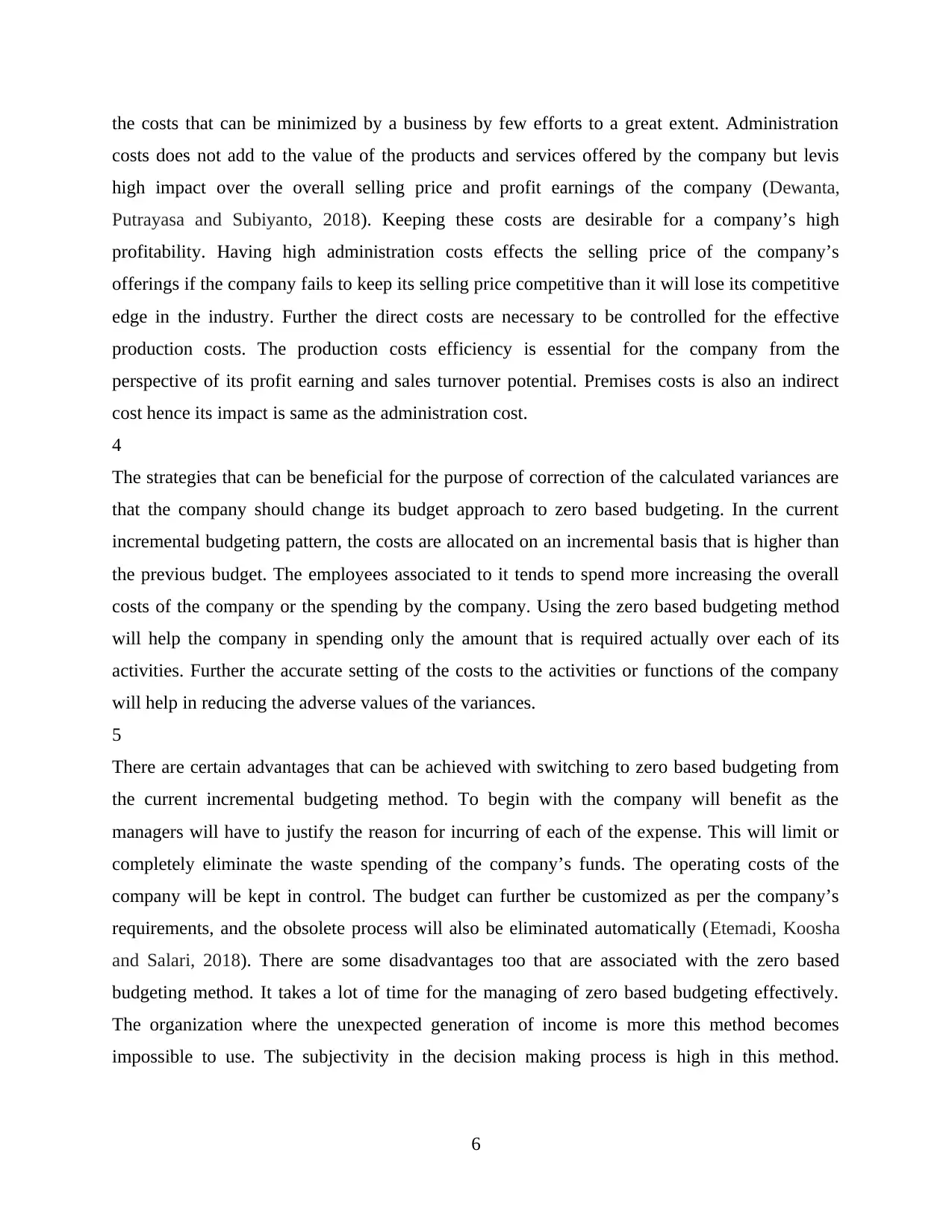
the costs that can be minimized by a business by few efforts to a great extent. Administration
costs does not add to the value of the products and services offered by the company but levis
high impact over the overall selling price and profit earnings of the company (Dewanta,
Putrayasa and Subiyanto, 2018). Keeping these costs are desirable for a company’s high
profitability. Having high administration costs effects the selling price of the company’s
offerings if the company fails to keep its selling price competitive than it will lose its competitive
edge in the industry. Further the direct costs are necessary to be controlled for the effective
production costs. The production costs efficiency is essential for the company from the
perspective of its profit earning and sales turnover potential. Premises costs is also an indirect
cost hence its impact is same as the administration cost.
4
The strategies that can be beneficial for the purpose of correction of the calculated variances are
that the company should change its budget approach to zero based budgeting. In the current
incremental budgeting pattern, the costs are allocated on an incremental basis that is higher than
the previous budget. The employees associated to it tends to spend more increasing the overall
costs of the company or the spending by the company. Using the zero based budgeting method
will help the company in spending only the amount that is required actually over each of its
activities. Further the accurate setting of the costs to the activities or functions of the company
will help in reducing the adverse values of the variances.
5
There are certain advantages that can be achieved with switching to zero based budgeting from
the current incremental budgeting method. To begin with the company will benefit as the
managers will have to justify the reason for incurring of each of the expense. This will limit or
completely eliminate the waste spending of the company’s funds. The operating costs of the
company will be kept in control. The budget can further be customized as per the company’s
requirements, and the obsolete process will also be eliminated automatically (Etemadi, Koosha
and Salari, 2018). There are some disadvantages too that are associated with the zero based
budgeting method. It takes a lot of time for the managing of zero based budgeting effectively.
The organization where the unexpected generation of income is more this method becomes
impossible to use. The subjectivity in the decision making process is high in this method.
6
costs does not add to the value of the products and services offered by the company but levis
high impact over the overall selling price and profit earnings of the company (Dewanta,
Putrayasa and Subiyanto, 2018). Keeping these costs are desirable for a company’s high
profitability. Having high administration costs effects the selling price of the company’s
offerings if the company fails to keep its selling price competitive than it will lose its competitive
edge in the industry. Further the direct costs are necessary to be controlled for the effective
production costs. The production costs efficiency is essential for the company from the
perspective of its profit earning and sales turnover potential. Premises costs is also an indirect
cost hence its impact is same as the administration cost.
4
The strategies that can be beneficial for the purpose of correction of the calculated variances are
that the company should change its budget approach to zero based budgeting. In the current
incremental budgeting pattern, the costs are allocated on an incremental basis that is higher than
the previous budget. The employees associated to it tends to spend more increasing the overall
costs of the company or the spending by the company. Using the zero based budgeting method
will help the company in spending only the amount that is required actually over each of its
activities. Further the accurate setting of the costs to the activities or functions of the company
will help in reducing the adverse values of the variances.
5
There are certain advantages that can be achieved with switching to zero based budgeting from
the current incremental budgeting method. To begin with the company will benefit as the
managers will have to justify the reason for incurring of each of the expense. This will limit or
completely eliminate the waste spending of the company’s funds. The operating costs of the
company will be kept in control. The budget can further be customized as per the company’s
requirements, and the obsolete process will also be eliminated automatically (Etemadi, Koosha
and Salari, 2018). There are some disadvantages too that are associated with the zero based
budgeting method. It takes a lot of time for the managing of zero based budgeting effectively.
The organization where the unexpected generation of income is more this method becomes
impossible to use. The subjectivity in the decision making process is high in this method.
6
Paraphrase This Document
Need a fresh take? Get an instant paraphrase of this document with our AI Paraphraser
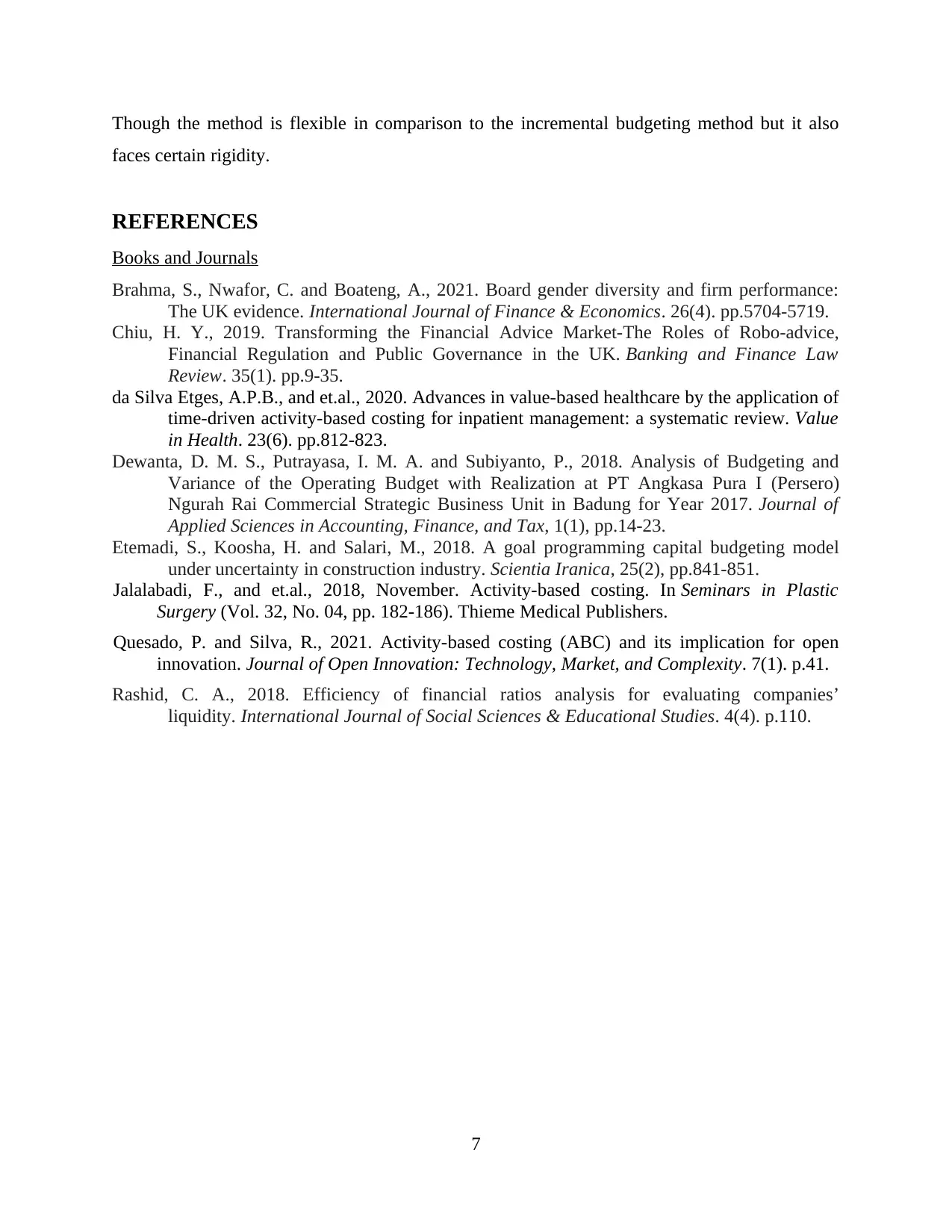
Though the method is flexible in comparison to the incremental budgeting method but it also
faces certain rigidity.
REFERENCES
Books and Journals
Brahma, S., Nwafor, C. and Boateng, A., 2021. Board gender diversity and firm performance:
The UK evidence. International Journal of Finance & Economics. 26(4). pp.5704-5719.
Chiu, H. Y., 2019. Transforming the Financial Advice Market-The Roles of Robo-advice,
Financial Regulation and Public Governance in the UK. Banking and Finance Law
Review. 35(1). pp.9-35.
da Silva Etges, A.P.B., and et.al., 2020. Advances in value-based healthcare by the application of
time-driven activity-based costing for inpatient management: a systematic review. Value
in Health. 23(6). pp.812-823.
Dewanta, D. M. S., Putrayasa, I. M. A. and Subiyanto, P., 2018. Analysis of Budgeting and
Variance of the Operating Budget with Realization at PT Angkasa Pura I (Persero)
Ngurah Rai Commercial Strategic Business Unit in Badung for Year 2017. Journal of
Applied Sciences in Accounting, Finance, and Tax, 1(1), pp.14-23.
Etemadi, S., Koosha, H. and Salari, M., 2018. A goal programming capital budgeting model
under uncertainty in construction industry. Scientia Iranica, 25(2), pp.841-851.
Jalalabadi, F., and et.al., 2018, November. Activity-based costing. In Seminars in Plastic
Surgery (Vol. 32, No. 04, pp. 182-186). Thieme Medical Publishers.
Quesado, P. and Silva, R., 2021. Activity-based costing (ABC) and its implication for open
innovation. Journal of Open Innovation: Technology, Market, and Complexity. 7(1). p.41.
Rashid, C. A., 2018. Efficiency of financial ratios analysis for evaluating companies’
liquidity. International Journal of Social Sciences & Educational Studies. 4(4). p.110.
7
faces certain rigidity.
REFERENCES
Books and Journals
Brahma, S., Nwafor, C. and Boateng, A., 2021. Board gender diversity and firm performance:
The UK evidence. International Journal of Finance & Economics. 26(4). pp.5704-5719.
Chiu, H. Y., 2019. Transforming the Financial Advice Market-The Roles of Robo-advice,
Financial Regulation and Public Governance in the UK. Banking and Finance Law
Review. 35(1). pp.9-35.
da Silva Etges, A.P.B., and et.al., 2020. Advances in value-based healthcare by the application of
time-driven activity-based costing for inpatient management: a systematic review. Value
in Health. 23(6). pp.812-823.
Dewanta, D. M. S., Putrayasa, I. M. A. and Subiyanto, P., 2018. Analysis of Budgeting and
Variance of the Operating Budget with Realization at PT Angkasa Pura I (Persero)
Ngurah Rai Commercial Strategic Business Unit in Badung for Year 2017. Journal of
Applied Sciences in Accounting, Finance, and Tax, 1(1), pp.14-23.
Etemadi, S., Koosha, H. and Salari, M., 2018. A goal programming capital budgeting model
under uncertainty in construction industry. Scientia Iranica, 25(2), pp.841-851.
Jalalabadi, F., and et.al., 2018, November. Activity-based costing. In Seminars in Plastic
Surgery (Vol. 32, No. 04, pp. 182-186). Thieme Medical Publishers.
Quesado, P. and Silva, R., 2021. Activity-based costing (ABC) and its implication for open
innovation. Journal of Open Innovation: Technology, Market, and Complexity. 7(1). p.41.
Rashid, C. A., 2018. Efficiency of financial ratios analysis for evaluating companies’
liquidity. International Journal of Social Sciences & Educational Studies. 4(4). p.110.
7
1 out of 8
Related Documents
Your All-in-One AI-Powered Toolkit for Academic Success.
+13062052269
info@desklib.com
Available 24*7 on WhatsApp / Email
![[object Object]](/_next/static/media/star-bottom.7253800d.svg)
Unlock your academic potential
Copyright © 2020–2025 A2Z Services. All Rights Reserved. Developed and managed by ZUCOL.




